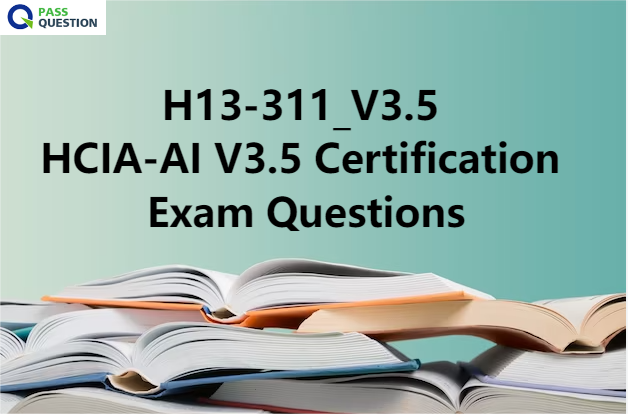H13-311_V3.5 HCIA-AI V3.5 Certification Exam Questions
To help you earn the HCIA-AI V3.5 Certification, you can get the latest H13-311_V3.5 HCIA-AI V3.5 Certification Exam Questions from PassQuestion, which is a reliable source to guarantee your success in the actual Huawei H13-311_V3.5 exam. By using the H13-311_V3.5 HCIA-AI V3.5 Certification Exam Questions, you will be well-prepared and confident, enabling you to clear the Huawei H13-311_V3.5 exam on your first attempt without any difficulties. By thoroughly preparing with these H13-311_V3.5 HCIA-AI V3.5 Certification Exam Questions, you will understand the exam content, enhance your test-taking skills, and boost your confidence, thereby increasing your likelihood of achieving certification on your first attempt.

HCIA-AI V3.5 Certification Exam
Passing the HCIA-AI V3.5 certification will indicate that you understand the AI development history, Huawei Ascend AI system, Huawei full-stack all-scenario AI strategy, cutting-edge AI applications, and algorithms related to traditional machine learning and deep learning. You will also be able to build, train, and deploy neural networks by using the MindSpore development framework, and be ready to take on AI positions in sales, marketing, product management, project management, technical support, and more. The target audience includes personnel who hope to become AI engineers, obtain an HCIA-AI certificate, or know how to use, manage, and maintain Huawei AI products and AI services. The prerequisites for this certification include possessing a basic knowledge of advanced mathematics and having studied the pre-course of "Math Basics," as well as being familiar with the Python language and having studied the pre-course of "Python Basics."
HCIA-AI V3.5 Exam Information
Exam Code: H13-311
Exam Name: HCIA-AI
Exam Language: ENU/CHS
Question Type: Single Answer, Multiple Answer, True-false Question, Fill in the blank answers, Drag and drop item
Exam Fees: 200 USD
Exam Duration: 90 min
Passing Score: 600 / 1000
HCIA-AI V3.5 Exam Knowledge Points
AI Overview 15%
- AI Overview
- Application Fields of AI
- Huawei's AI Development Strategy
- Controversies Over AI and Its Future
Machine Learning Overview 20%
- Machine Learning Algorithms
- Types of Machine Learning
- Machine Learning Process
- Important Machine Learning Concepts
- Common Machine Learning Algorithms
Deep Learning Overview 25%
- Deep Learning
- Training Rules
- Activation Functions
- Normalization
- Optimizers
- Neural Network Types
AI Development Framework 20%
- AI Framework Development
- MindSpore
- MindSpore Features
- MindSpore Development Components
- AI Application Development Process
Introduction to Huawei AI Platforms 14%
- Huawei Ascend Computing Platform
- Huawei Cloud EI Platform
- Huawei Device AI Platforms
Cutting-edge AI applications 6%
- Reinforcement Learning
- GAN
- Knowledge Graph
- Intelligent Driving
- Quantum Computing and Machine Learning
View Online HCIA-AI V3.5 Certification H13-311_V3.5 Free Questions
1. Which of the following technologies is commonly used for image feature extraction and related research?
A. Convolutional neural network
B. Naive Bayes classification algorithm
C. Long short-term memory (LSTM) network
D. Word2Vec
Answer: A
2. "Batch inference is a batch job that performs inference on batch data. There is no need for model training before using batch inference." Which of the following is true about this statement?
A. This statement is correct. With batch inference, training is no longer required.
B. This statement is correct. Inference means the end of training.
C. This statement is incorrect. Model training is required before inference is performed.
D. This statement is incorrect. No training is required before batch inference.
Answer: C
3. Consider a scenario where a machine learning algorithm is used to filter spam. According to the definition of machine learning, which of the following describes the experience E?
A. Spam filtering
B. Accuracy of spam filtering
C. All tagged spam and genuine emails in the past three years
D. Email addresses
Answer: C
4. A computer uses labeled images to learn and determine which images contain apples and which contain pears. Which of the following types of machine learning is most applicable to this scenario?
A. Supervised learning
B. Unsupervised learning
C. Semi-supervised learning
D. Reinforcement learning
Answer: A
5. Which of the following statements is true about classification models and regression models in machine learning?
A. For regression problems, the output variables are discrete values. For classification problems, the output variables are continuous values.
B. The most commonly used indicators for evaluating regression and classification problems are accuracy and recall rate.
C. There may be overfitting in both regression and classification problems.
D. Logistic regression is a typical regression model.
Answer: C
6. During neural network training, which of the following values is continuously updated by using the gradient descent method to minimize the loss function?
A. Hyperparameter
B. Feature
C. Number of samples
D. Parameter
Answer: D
7. Which of the following are topics of speech processing research?
A. Speech recognition
B. Voice processing
C. Speech wake-up
D. Voiceprint recognition
Answer: ABCD
8. Which of the following are false about convolutional neural networks?
A. A convolutional neural network may contain convolutional, pooling, and fully connected layers.
B. Convolution kernels cannot extract global features of images.
C. Common pooling includes max pooling and average pooling.
D. When an image is processed, convolution is implemented by using a scanning window.
Answer: B
9. Overfitting problems can be avoided through dataset expansion. Which of the following statements is true about dataset expansion?
A. The larger the dataset, the lower the probability of overfitting.
B. The larger the dataset, the higher the probability of overfitting.
C. The smaller the dataset, the lower the probability of overfitting.
D. The probability of overfitting decreases when the dataset increases or decreases.
Answer: A
10. Which of the following is NOT a complexity feature of Al computing?
A. Mixed precision computing
B. Parallel data and computing
C. Parallel communication and computing
D. Parallel processing of structured and unstructured data
Answer: D
- TOP 50 Exam Questions
-
Exam
All copyrights reserved 2026 PassQuestion NETWORK CO.,LIMITED. All Rights Reserved.

